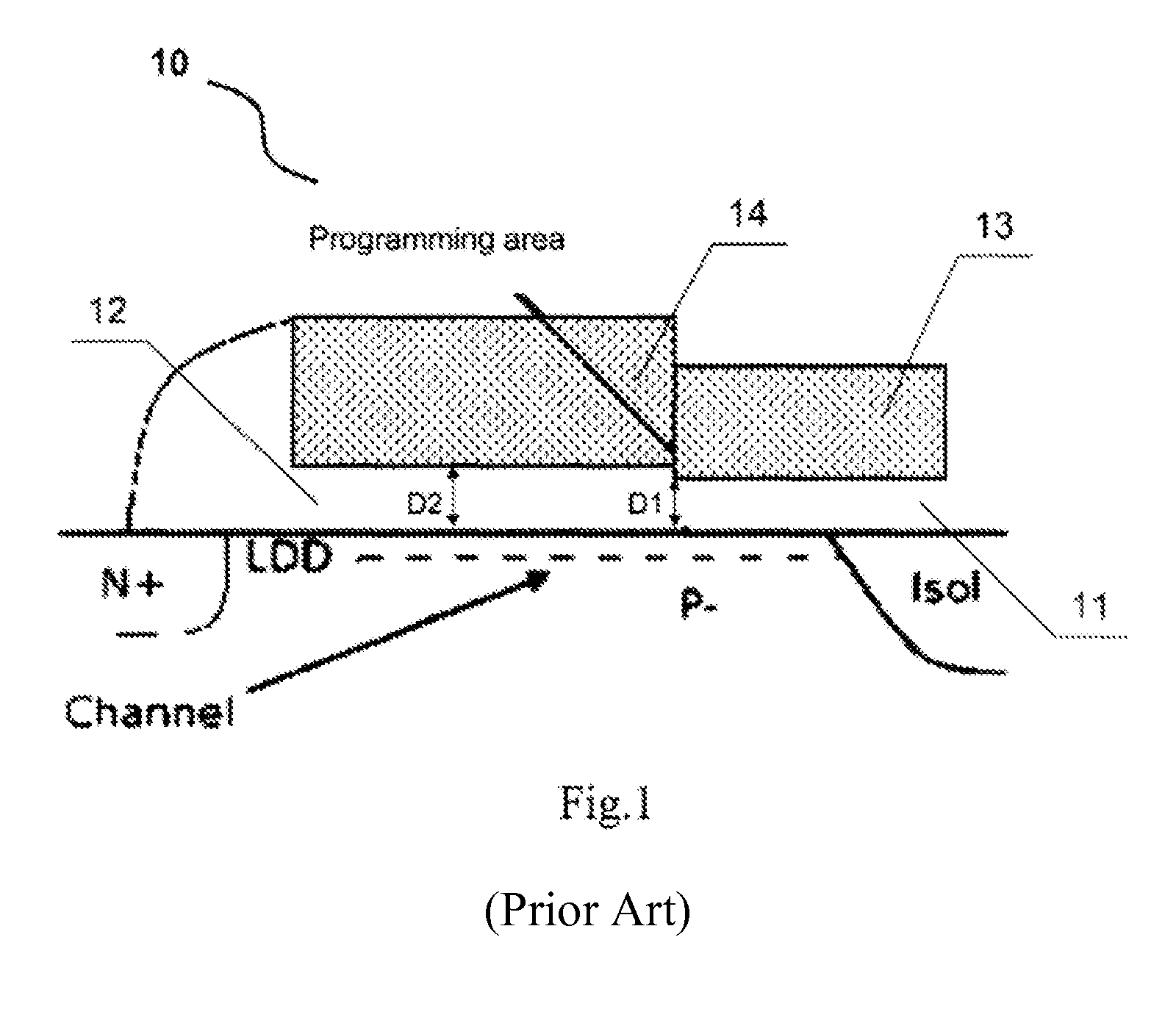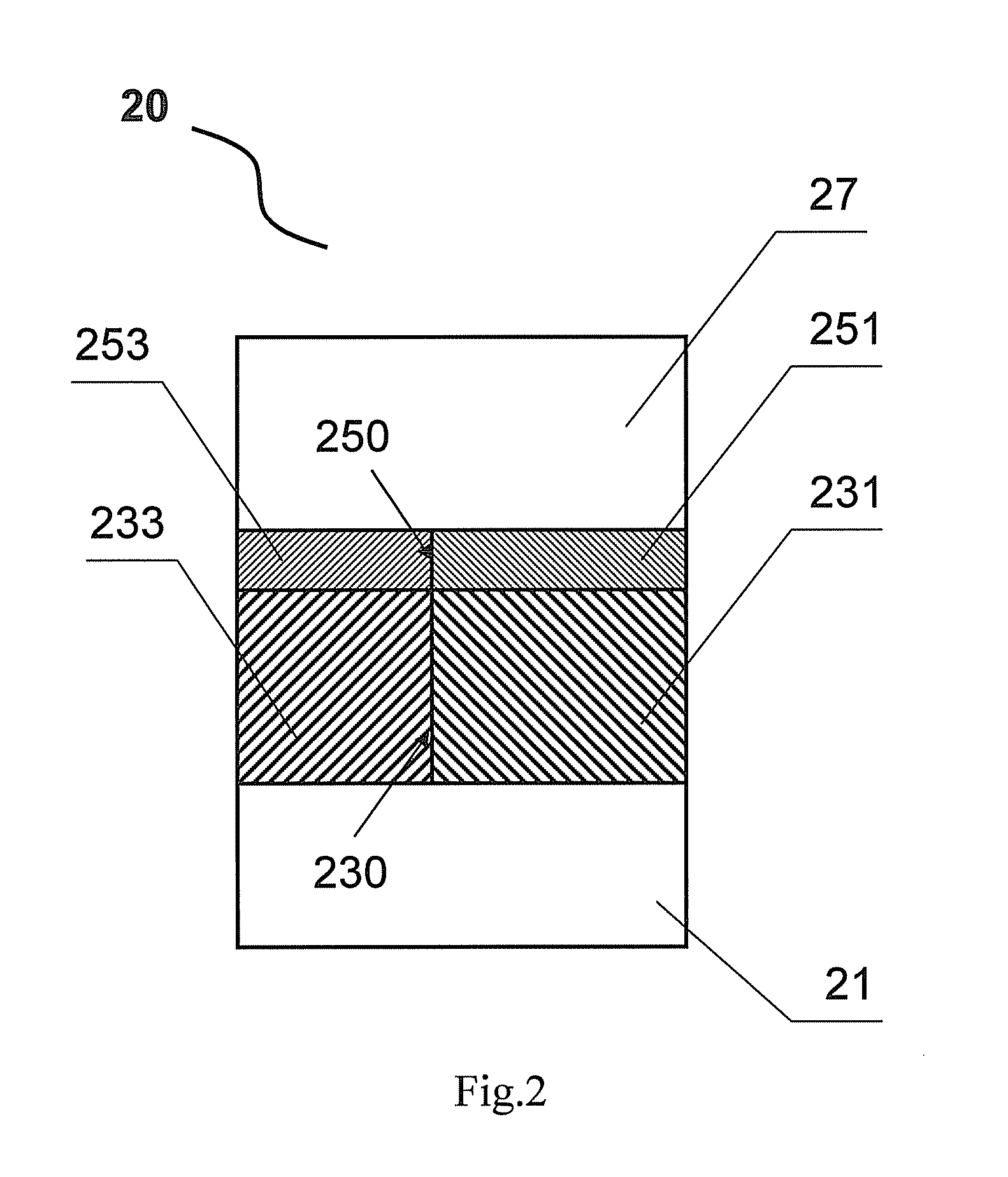One-time programmable memory cell, memory and manufacturing method thereof
a one-time programmable memory and memory technology, applied in the direction of transistors, semiconductor/solid-state device details, instruments, etc., can solve the problems of soft breakdown, high power consumption loss, and large power consumption of otp, and achieve the effect of reducing the programming voltag
- Summary
- Abstract
- Description
- Claims
- Application Information
AI Technical Summary
Benefits of technology
Problems solved by technology
Method used
Image
Examples
first embodiment
[0056]FIG. 2 is a schematic structural view of an OTP unit in accordance with a first embodiment provided by the invention. In this embodiment, the basic structure of the OTP unit will be described in a simple MIM (metal-insulator-metal) schematic structural view. However, those skilled in the art will appreciate that the OTP unit does not merely comprise the basic structural part shown in FIG. 2. As shown in FIG. 2, the OTP unit 20 also comprises a lower electrode 21 and an upper electrode 27. In this embodiment, a first metal layer 231 and a second metal layer 233 are simultaneously formed on the upper surface of the lower electrode 21. Apparently, the first metal layer 231 and the second metal layer 233 are located in the same layer and adjoin with each other, thus forming the adjoining area 230 shown in the figure. A first metal oxide layer 251 having dielectric characteristic is formed by oxidizing the first metal layer 231, and a second metal oxide layer 253 having dielectric ...
second embodiment
[0062]FIG. 3 is a schematic structural view of an OTP unit in accordance with a second embodiment provided by the invention. Similarly, the OTP unit 30 comprises a lower electrode 21, a first metal layer 331, a second metal layer 333, a first metal oxide layer 351, a second metal oxide layer 353 and an upper electrode 37. An adjoining area 330 exists between the first metal layer 331 and the second metal layer 333, and an adjoining area 350 exists between the first metal oxide layer 351 and the second metal oxide layer 353. The main difference from the OTP unit 20 shown in FIG. 2 lies in that the thicknesses of the first metal oxide layer 351 and the second metal oxide layer 353 that are substantially located in the same layer are different. For example, in this embodiment, the thickness of the second metal oxide layer 353 is smaller than that of the first metal oxide layer 351, and the specific range of thickness difference can be 2-20 nm, e.g., 5 nm, which is not limiting. This is...
third embodiment
[0063]FIG. 4 is a schematic structural view of an OTP unit in accordance with a third embodiment provided by the invention. Just as described previously, since the OTP unit of the invention is based on metal oxides, it can be formed in a back-end structure of integrated circuit, and the OTP unit 40 of the embodiment shown in FIG. 4 is an OTP unit integrated in the back-end structure. As shown in FIG. 4, the OTP unit 40 also comprises a first metal layer 431, a second metal layer 433, a first metal oxide layer 451, a second metal oxide layer 453, and an upper electrode 47. An adjoining area 430 exists between the first metal layer 431 and the second metal layer 433, and an adjoining area 450 exists between the first metal oxide layer 451 and the second metal oxide layer 453. In this embodiment, the first metal layer 431 and the second metal layer 433 are lead wires in the back-end structure, and the first metal layer 431 and the second metal layer 433 also serve as the lower electrod...
PUM
| Property | Measurement | Unit |
|---|---|---|
| thicknesses | aaaaa | aaaaa |
| thicknesses | aaaaa | aaaaa |
| thickness | aaaaa | aaaaa |
Abstract
Description
Claims
Application Information
 Login to View More
Login to View More - R&D
- Intellectual Property
- Life Sciences
- Materials
- Tech Scout
- Unparalleled Data Quality
- Higher Quality Content
- 60% Fewer Hallucinations
Browse by: Latest US Patents, China's latest patents, Technical Efficacy Thesaurus, Application Domain, Technology Topic, Popular Technical Reports.
© 2025 PatSnap. All rights reserved.Legal|Privacy policy|Modern Slavery Act Transparency Statement|Sitemap|About US| Contact US: help@patsnap.com



